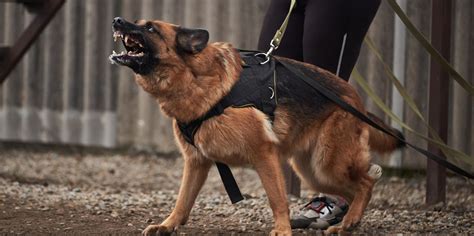Understanding Aggression: Facts and Figures
Aggressive behavior in dogs is a serious issue that can result in injury to humans and other animals. According to the American Veterinary Medical Association (AVMA), approximately 1 million dog bites occur in the United States each year, with 18% of bites resulting in hospitalization.

Root Causes of Aggression
Aggression in dogs can stem from various underlying factors, including:
- Fear and Anxiety: Dogs may act aggressively out of fear or anxiety when they feel threatened or overwhelmed.
- Dominance: Some dogs may exhibit aggression to establish or maintain dominance over other animals or humans.
- Pain or Discomfort: Underlying medical conditions, such as injuries or infections, can cause pain or discomfort, leading to defensive aggression.
- Poor Socialization: Inadequate socialization during puppyhood can hinder the development of appropriate social skills, making dogs more prone to aggression.
- Genetics: Studies have suggested that certain breeds may have a genetic predisposition to aggressive behavior.
Understanding Body Language Cues
Dogs often communicate their intentions through subtle body language cues. Recognizing these cues can help prevent aggressive incidents.
- Staring: Direct eye contact can be perceived as a challenge or threat.
- Lip Curls: Curled lips, especially accompanied by bared teeth, indicate aggression.
- Ears Back: Flattened or pinned-back ears suggest fear or aggression.
- Tail Wagging: Contrary to popular belief, wagging does not always indicate friendliness. A low, stiff wag can be a sign of aggression.
- Growling: Growling is a vocal warning that should not be ignored.
Types of Aggression
There are several types of aggression that dogs may exhibit:
- Territorial Aggression: Dogs defend their perceived territory from perceived threats.
- Possessive Aggression: Dogs guard objects or people they view as their property.
- Fear Aggression: Dogs act aggressively out of fear or anxiety.
- Protective Aggression: Dogs may become aggressive to protect themselves or their loved ones.
- Play Aggression: Puppies often engage in rough play, which can teeter into aggression if not redirected.
Dealing with Aggressive Dogs: A Step-by-Step Approach
Addressing aggression in dogs requires a multifaceted approach:
- Identify the Root Cause: Determine the underlying factors triggering aggression.
- Seek Professional Help: Consult with a certified veterinarian or animal behaviorist to diagnose medical conditions and develop a treatment plan.
- Modify the Environment: Remove triggers that contribute to aggression, such as perceived threats or situations that cause anxiety.
- Training and Behavior Modification: Implement training techniques that promote calmness and teach dogs appropriate social behaviors.
- Medication: In severe cases, medication may be necessary to reduce anxiety or aggression.
Case Studies: Exploring Real-World Scenarios
- Case 1: A female Golden Retriever exhibited aggression towards new people entering her home. Training her to associate new people with positive experiences (e.g., treats) helped mitigate her territorial aggression.
- Case 2: A male German Shepherd displayed protective aggression towards his owner. By providing a safe space and teaching him to tolerate strangers, the aggression was reduced.
- Case 3: A puppy showed excessive play aggression towards other puppies. Redirecting his energy with appropriate chew toys and structured play sessions helped curb his aggression.
Future Trends and Innovative Solutions
Artificial Intelligence (AI): AI algorithms can analyze dog behavior and identify patterns that may indicate aggression.
Smart Collars: Smart collars with sensors can monitor a dog’s heart rate and other vital signs, providing early warnings of aggression.
Virtual Reality (VR): VR simulations can expose dogs to controlled situations, allowing them to practice and improve their social skills safely.
Conclusion
Decoding aggression in dogs requires a comprehensive understanding of their behavior and psychology. By identifying the root causes, implementing evidence-based approaches, and utilizing innovative technologies, we can effectively address aggression and promote the well-being of both dogs and humans.





















